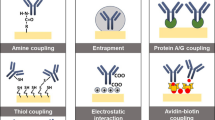Abstract
Transfusion medicine is a field that has developed in the second half of the last century. Very rapidly, however, it became clear that this approach also carried its problems, such as the incompatibility of red blood cells and plasma between donors and recipients, and the possibility of transmitting viral and bacterial infections. An immunomagnetic biosensor for the label-free detection of a bacterial model, Escherichia coli, is described and compared to a self assembled multilayer system reported previously. The paramagnetic nanoparticles layer attracted to, and formed on, the gold electrode surface via a magnetic field up to 300 mT is not totally blocking for the redox probe comparing to the thiol self assembled monolayer (a biotin thiol and a spacer thioalcohol). Moreover, the modeling of the Nyquist spectra obtained by electrochemical impedance spectroscopy for increasing concentrations of E. coli shows for both system a sigmoid variation of the polarization resistance with increasing logarithmic concentration of bacteria. A sensitivity slope of 10.675 was obtained for the immunomagnetic sensor compared to 6.832 for the self assembled multilayer process, this indicating the higher sensitivity of the paramagnetic nanoparticles biosensor.




Similar content being viewed by others
References
Blajchman MA, Beckers EAM, Dickmeiss E, Lin L, Moore G, Muylle L (2005) Bacterial detection of platelets: current problems and possible resolutions. Transfus Med Rev 19:259
Bihl F, Castelli C, Marincola F, Dodd RY, Brander C (2007) Transfusion-transmitted infections. J Transl Med 5:1
Baselt DR, Lee GU, Natesan M, Metzger SW, Sheehan PE, Colton RJ (1998) A biosensor based on magnetoresistance technology. Biosens Bioelectron 13:731
Jaffrezic-Renault N, Martelet C, Chevolot Y, Cloarec JP (2007) Biosensors and bio-bar code assays based on biofunctionalized magnetic microbeads. Sensors 7:589
Pankhurst QA, Connolly J, Jones SK, Dobson J (2003) Applications of magnetic nanoparticles in biomedicine. J Phys D Appl Phys 36:167
Gijs MAM (2004) Magnetic bead handling on-chip: new opportunities for analytical applications. Microfluid Nanofluid 1:22
Shinkai MJ (2002) Functional magnetic particles for medical application. Biosci Bioeng 94:606
Wang J (2005) Nanomaterial-based electrochemical biosensors. Analyst 130:421
Meyer MHF, Stehr M, Bhuju S, Krause HJ, Hartmann M, Miethe P, Singh M, Keusgen M (2007) Magnetic biosensor for the detection of Yersinia pestis. J Microbiol Meth 68:218
Molday RS, MacKenzie D (1982) Immunospecific ferromagnetic irondextran reagents for the labeling and magnetic separation of cells. J Immunol Meth 52:353
Tibbe A, De Grooth B, Greve J, Liberti P, Dolan G, Terstappen L (1999) Optical tracking and detection of immunomagnetically selected and aligned cells. Nature Biotechnol 17:1210
Kularatne BY, Lorigan P, Browne S, Suvarna SK, Smith MO, Lawry J (2002) Monitoring tumour cells in the peripheral blood of small cell lung cancer patients. Cytometry 50:160
Zigeuner RE, Riesenberg R, Pohla H, Hofstetter A, Oberneder R (2003) Isolation of circulating cancer cells from full blood by immunomagnetic cell enrichment (ICE) and immunocytochemistry in vitro. J Urol 169:701
Hu XC, Wang Y, Shi DR, Loo TY, Chow LW (2003) Immunomagnetic tumor cell enrichment is promising in detecting circulating breast cancer cells. Oncology 64:160
Morisada S, Miyata N, Iwahori K (2002) Immunomagnetic separation of scum-forming bacteria using polyclonal antibody that recognizes mycoloic acids. J Microbiol Meth 51:141
Maalouf R, Fournier-Wirth C, Coste J, Chebib H, Saïkali Y, Vittori O, Errachid A, Cloarec JP, Martelet C, Jaffrezic-Renault N (2007) Label-free detection of bacteria by electrochemical impedance spectroscopy: comparison to surface plasmon resonance. Anal Chem 79:4879
Spinke J, Liley M, Schmitt FJ, Guder HJ, Angermaier L, Knoll W (1993) Molecular recognition at self-assembled monolayers—optimization of surface functionalization. J Chem Phys 99:7012
Janek RP, Fawcett WR, Ulman A (1998) Impedance spectroscopy of self-assembled monolayers on Au(111): sodium ferrocyanide charge transfer at modified electrodes. Langmuir 14:3011
Vermette P, Gengenbach T, Divisekera U, Kambouris PA, Griesser HJ, Meagher L (2003) Immobilization and surface characterization of neutravidin biotin-binding protein on different hydrogel interlayers. J Colloid Interface Sci 259:13
Finklea HO (1996) Electrochemistry of organized monolayers of thiols and related molecules on electrodes. In: Bard AJ, Rubinstein I (eds) Electroanalytical chemistry. Marcel Dekker, New York, 19:109
Bard AJ, Faulkner LR (2001) Electrochemical methods. Fundamentals and applications, 2nd ed. Wiley, New York
Goubault C, Jop P, Fermigier M, Baudry J, Bertrand E, Bibette J (2003) Flexible magnetic filaments as micromechanical sensors. J Phys Rev Lett 91:260802
Goubault C, Leal-Calderon F, Viovy JL, Bibette J (2005) Self-assembled magnetic nanowires made irreversible by polymer bridging. Langmuir 21:3725
Furst EM, Suzuki C, Fermigier M, Gast AP (1998) Permanently-linked monodisperse paramagnetic chains. Langmuir 14:7334
Maalouf R, Chebib H, Saïkali Y, Vittori O, Sigaud M, Jaffrezic-Renault N (2007) Amperometric and impedimetric characterization of a glutamate biosensor based on NafionÒ and a methyl viologen modified glassy carbon electrode. Biosens Bioelectron 22:2682
Author information
Authors and Affiliations
Corresponding authors
Rights and permissions
About this article
Cite this article
Maalouf, R., Hassen, W.M., Fournier-Wirth, C. et al. Comparison of two innovatives approaches for bacterial detection: paramagnetic nanoparticles and self-assembled multilayer processes. Microchim Acta 163, 157–161 (2008). https://doi.org/10.1007/s00604-008-0008-3
Received:
Accepted:
Published:
Issue Date:
DOI: https://doi.org/10.1007/s00604-008-0008-3




